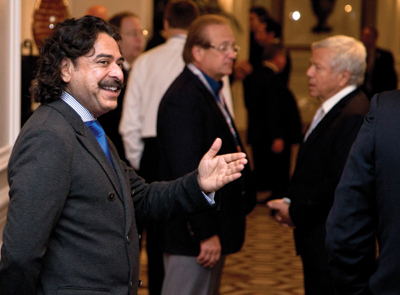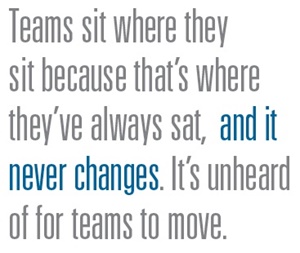When a new NFL owner arrives at a league meeting for the first time, the commissioner introduces the person before the entire ownership, and the new member of the group then offers a few comments.
After Minnesota Vikings owner Zygi Wilf concluded some brief words to the room at his inaugural owners meeting in 2005, he pivoted to then-commissioner Paul Tagliabue and asked, “Now, where do I sit?”
Where the owners and their staffs sit at league meetings, including for the annual NFL gathering that starts Sunday in Orlando, is cemented through a combination of time-honored tradition and some grade-school, seat-saving flair.
In the early morning hours of meeting days, often hours before the sessions begin, team executives will scurry to the then-vacant conference room where the owners will gather later. There, they’ll jot down their team names on slips of paper — looking to claim their seats with those notes just as if they were saving seats for friends back at assembly or in the lunch room years ago.
The team representatives will occasionally make notes for their colleagues from other clubs, as well, if perhaps there was an urgent message communicated in the form a late-night text or an email, often sent from a plane.
 |
When Jaguars owner Shad Khan attends meetings, he sits next to the Cowboys.
Photo by: AP IMAGES
|
“We came into the league in 1993, and ‘the notepad’ was in existence then,” said former Jacksonville Jaguars executive Paul Vance, referring to the paper that’s set up just inside the meeting room’s doorway that waits for deployment in the team-name scribbling exercise.
Vance, who recounted Wilf’s comments, said that in all likelihood they were made in jest. (Wilf’s brother, Vikings President Mark Wilf, said he could not recall exactly what was said at that time.) Chances are, Vance said, Wilf had already been told where to sit because the Vikings, like all teams, always occupy the same place in the room.
This marks the traditional (some would say feudal) part of the seating arrangement: Teams sit where they sit because that’s where they’ve always sat, and it never changes. It’s unheard of for teams to move, or to even to a request a move.
So when those representatives are scurrying to the meeting room in those early-morning hours — and it’s often team presidents and general managers doing the seat-claiming, given that it’s only top-level executives at the meetings — they’re doing so to mark the very spots where everyone assumes they’ll sit anyway.
“Everyone sits in the same place every time,” said one team executive, who like many interviewed for this story did not want to be quoted on the subject because of the sensitivity of discussing anything that happens when all 32 team leaders are together in one room. “I could draw up a map right now and show where everyone will sit [next week].”
Prime Real Estate
So how do other leagues go about setting up their rooms for prime meetings? Here’s a look inside their owners’ rooms, as communicated by league and team personnel.
■ MLB: Meetings often have a head table that includes Commissioner Bud Selig and other senior executives who provide committee and operating-unit reports to owners. Beyond that, team seating locations change for each meeting. Those positions are assigned by MLB and are designated by team logo cards on tables. Over a year or two, any one particular team could find itself at the front, in the middle and at the rear of a meeting room. This constant shifting of seating locations is aimed in part at promoting better collegiality among owners.
MLB owners meet quarterly, and one tradition for the meeting that’s held each November is to place executives from the two teams that participated in the just-completed World Series toward the front of the room.
■ NBA: At New York’s St. Regis Hotel, the home for the NBA’s Board of Governors meetings, the league typically has had its owners seated in a square-shaped configuration inside a conference room. The league’s commissioner and senior staff sit in the middle of the square opposite the doorway. Owners and executives from each team sit together. Sometimes, teams are in alphabetical order; other times, they are arranged alphabetically by their geographic names.
That, however, is just how it’s been done in the past. Whether a different setup will occur under new Commissioner Adam Silver remains to be seen. He’ll preside over his first BOG meeting next month.
■ NHL: The setup is a hollow square, with league executives at the head table. Seating order of club representatives starts from the left side with Anaheim and works around alphabetically to Winnipeg.
■ MLS: At MLS board meetings, the owners sit by team in a large rectangle in a room with Commissioner Don Garber; Mark Abbott, president and deputy commissioner; and Gary Stevenson, MLS business ventures president and managing director; and other league senior executives participating in the meeting. It’s a system that travels, too, as board meetings have taken place in hotel ballrooms, stadiums such as Sporting Park in Kansas City, and other facilities.
— Compiled by Christopher Botta,
Eric Fisher and John Lombardo
Here’s how they sit: The meeting room is designed as a sideways E, with the spine of the letter representing the lead table, where league executives and the commissioner will sit. That table resides at the front of the room, with the three legs of the E extending toward the entry doors.
The Oakland Raiders are always at the back, the spot from which late owner Al Davis liked to survey his peers. Davis, who died in 2011, likely would have had the chance to choose where exactly in the room he wanted to sit because he had been going to meetings since the 1960s, when his team was merged into the NFL as part of the AFL-NFL combination.
The New York Giants and the Pittsburgh Steelers, two other longtime entrants in the NFL, have their place in the back of the room, too, near each other. That positioning is the result of the longtime friendships of the owning Mara and Rooney families, who likely at some point in the distant past, before the seating became calcified, chose to sit close to each other.
It’s because of traditions like those that the continued use of the notepad is one of the peculiarities of the system. Several years ago, Amy Trask, then the Oakland Raiders president, said she suggested a resolution that would formalize the seating and do away with the paper.
“Perhaps it was somewhat tongue in cheek: that we should adopt, vote on, a formal seating-assignment chart,” she said. The vote went nowhere.
How secure is the notepad’s place in the setup? The league over the last 18 months has been putting framed, printed team names in position on the tables in front of the clubs’ seats — but doing so only after the ritual of the paper has clearly marked each club’s territory.
The paper notes have more utility the first morning of the annual meeting, when the commissioner’s address to owners has been moved in recent years to larger quarters. This room does not have the accustomed E table setup, so marking seats has an extra significance there.
Vance, who is now semi-retired and living in New Hampshire, said that what he found interesting about the rigid seating arrangement is that it means an owner who is coming into the league who might be the boss of his own company doesn’t get to choose where he wants to sit at a meeting of his now-peers at the NFL. That, of course, meshes with the ethos of the NFL: that the owners compete on Sundays but cooperate the rest of the week.
The seating system serves a practical purpose in one sense. If the commissioner wants to call on a particular owner, he knows — (because of tradition) exactly where in the room to look to find that person. There are well more than 100 people in the room for particular meetings, considering owners and staff members, so knowing where everyone is sitting helps keep things moving.
And while the note-writing tradition does hark back to childhood days, there’s no school-like clique setup that has developed through the years, where like-minded people gravitate toward each other. The Jaguars, a low-revenue team, for example, sit next to the high-dollar Dallas Cowboys.
“People may think there is some strategic reason where teams sit,” Vance said, “and I don’t think there is. It is just habit, convenience. And I don’t think there is a ‘left’ and ‘right’ in the room.”





